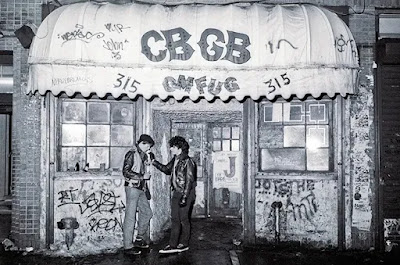Previously posted on my Facebook Page.
FAMOUS CLUBS. CBGB was a New York City music club opened in 1973 by Hilly Kristal in Manhattan's East Village. The club was previously a biker bar. The letters CBGB were for “Country, Bluegrass, and Blues,” Kristal's original vision, yet CBGB soon became a famed venue of punk rock and new wave bands like the Ramones, Television, Patti Smith Group, Blondie, and Talking Heads. From the early 1980s onward, CBGB was known for hardcore punk. (Photo: Billboard.) 🎼🎸🎼
EVENTS in HISTORY. Tiananmen Square Protests of 1989, precipitated by the death of pro-reform Chinese Communist Party general secretary Hu Yaobang in April 1989 amid the backdrop of rapid economic development and social change in post-Mao China, reflecting anxieties among the people and political elite about the country's future. The event also signaled the demise of the Gang of Four, the last remnant of Mao Zedong’s leadership. 🇨🇳✊🇨🇳
The 1944 Bretton Woods Agreement gave birth to the Bretton Woods system of monetary management, which established the rules for commercial relations among the United States, Western European nations, and 44 other countries. Held in Bretton Woods in New Hampshire on July 1-22, 1944, the summit rebuilt the international economic system while World War II was still being fought. From this, emerged the International Monetary Fund and World Bank. 🏢💰🏢
FAMOUS EVENTS. October 4, 1957: The Space Age began as the Soviet Union launched Sputnik 1, the first artificial satellite, into orbit. Sputnik 1 was launched into an elliptical low Earth orbit by the USSR as part of the Soviet space program. It sent a radio signal back to Earth for three weeks before its three silver-zinc batteries ran out. Aerodynamic drag caused it to fall back into the atmosphere on 4 January 1958. 🛰🚀🛰
Running the bulls. The most famous bull-run is the encierro held in Pamplona in Spain during the nine-day festival of Sanfermines in honor of Saint Fermin. The event has its origins in the old practice of transporting bulls from the fields outside the city, where they were bred. During this "run,” local youths would jump among them in a display of bravado. It has become a major global tourism event, today very different from the traditional, local festival. (Photo: Global News.) 🦬🦬🏃♂️
FAMOUS STRUCTURES. The Statue of Liberty is a colossal neoclassical sculpture on Liberty Island in New York Harbor in New York City. The copper statue, a gift from the people of France, was designed by French sculptor Frédéric Auguste Bartholdi and its metal framework was built by Gustave Eiffel. The statue was dedicated on October 28, 1886. The statue is a figure of Libertas, the Roman Goddess of Liberty. 🇫🇷🗽🇺🇸
Great Wall of China or Wanli Changcheng, literally "ten thousand long wall.” A series of fortifications that were built across the northern borders of ancient Chinese states and Imperial China as early as the 7th century BC. Served as protection against various nomadic groups from the Eurasian Steppe. Apart from defense, other purposes included border controls, which allows imposition of duties (and regulation) on goods transported along the Silk Road. 🇨🇳🥢🇨🇳
AGREEMENTS to REMEMBER. The Mérida Initiative is a security cooperation agreement among the United States, the government of Mexico and Central America, with the aim of combating threats of drug trafficking, transnational organized crime and money laundering. The assistance includes training, equipment and intelligence. The U.S. Congress authorized $1.6 billion for the three-year initiative (2007–2010). Whatever happened to the “agreement” is a matter of political insight. 🇺🇸💉🇲🇽
The DAY of the DEAD or “Día de los Muertos” is a holiday traditionally celebrated on November 1 and 2, and widely observed in Mexico. Although related to the simultaneous Christian remembrances for Hallowtide, it has a much less solemn tone and is portrayed as a holiday of joyful celebration rather than mourning. The multi-day holiday involves family and friends gathering to pay respects and to remember friends and family members who have died. (Photo: TAFER.) 🧟♀️🧛♂️🧟
TERMS to KNOW. Low-intensity conflict (or LIC) is a military conflict, usually localized, between two or more state or non-state groups which is below the intensity of conventional war. It involves the state's use of military forces applied selectively and with restraint to enforce compliance with its policies or objectives. Low-intensity conflict is usually sponsored by a superpower foreign government. LIC was prevalent in the Philippines during dictatorship years, 1970s to late-1980s. ☮️🇵🇭☮️



No comments:
Post a Comment